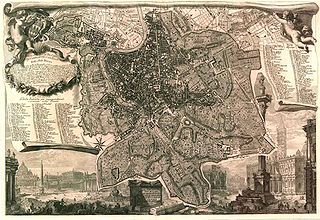- Giambattista Nolli
-
 detail from the Nolli map depicting the Pantheon.
detail from the Nolli map depicting the Pantheon.
Giambattista Nolli (or Giovanni Battista, April 9 1701 – July 1 1756) was an Italian Architect and Surveyor.
Born in Como, he moved to Rome thanks to the patronage of members of the patrician Albani and Corsini families. He is best known for his ichnographic plan of Rome, the Pianta Grande di Roma which he began surveying in 1736 and engraved in 1748, and now universally known as the Nolli Map. The map is composed of 12 copper plate engravings that together measures 176x208 cms and was published in response to the commission of Pope Benedict XIV to survey Rome in order to help create demarcations for the 14 traditional rioni or districts.[1]It was by far the most accurate description of Rome produced to date at a time when the architectural achievement of the Papacy was in full flower.
The Nolli map reflects Bufalini's map of 1551, with which Nolli readily invited comparison, however Nolli made a number of important innovations. Firstly, Nolli reorients the city from east (which was conventional at the time) to magnetic north, reflecting Nolli's reliance on the compass to get a bearing on the city's topography. Secondly, though he follows Bufalini in using a figure-ground representation of built space with blocks and building shaded in a dark poché, Nolli represents enclosed public spaces such as the colonnades in St. Peter's Square and the Pantheon as open civic spaces. Finally, the map was a significant improvement in accuracy, even noting the asymmetry of the Spanish Steps. The map was used in government planning for the city of Rome until the 1970s;[2]it was used as a base map for all Roman mapping and planning up to that date.
The map is framed with a vedute by Stefano Pozzi. A scaled-down edition, a collaboration between Nolli and Giovanni Battista Piranesi, was published in the same year the original map was finished. Piranesi was instrumental in getting the work printed; Giuseppe Vasi also contributed.
As an architect, he worked on the churches of San Dorotea in Trastevere (1751–1756) and Sant'Alessio on the Aventine Hill (1743).
Contents
Nolli Map
Nolly map is a map to measure the density of cities mainly in black and white. Nolly map was invented in 1748 when Italian architect Giambattista Nolli drew the map of Rome for Pope Benedict the 14th. Nolly was one of the first people who used orthogonal rotation representation map of the city, compared with conventional representations at the time of the bird's eye view. Accurate map and compare it to air photography.
One of the things on the map is the form Nolly choose to represent the area of the city. While buildings are shown in black, as white displays looms all the city's public space, it also includes the inner space of the churches and the monasteries and palaces and courtyards. This representation method has become widely accepted urban design, as a way to show the public space. Result from the way this representation of beauty can be great shade of public space in Rome, and that every corner of it is "positive. " Wherever you are, you're part of a convex space that surrounds you like a room. Another interesting feature is to combine that built the open space as defined. Buildings define the open space, open space and the buildings. Compared with the most common method today is floating in buildings without reference to him.
Notes
- ^ Tracing Architecture, Dana Arnold, 2003
- ^ see http://nolli.uoregon.edu/nuovaPianta.html
References
There have been a number of facsimile editions of the Nolli Map, two are listed here:
- 'The Nolli Plan of Rome: Facsimile', Full-size facsimile portfolio of the original 19 sheets 56cm x 81cm [22"x 32"] with 12pp intro. by Allen Ceen; J. H. Aronson Publisher, Highmount, NY 12441, 1st Ed. 1984, 2nd Ed. 1991. Distributed by Imago Terrae, P.O.Box 576, Pine Hill, NY 12465, http://www.imago-terrae.com . Imago-Terrae also distributes a 1/2 size single-sheet poster of the Nolli map 96cm x 108cm (36" x 43") published by J.H.Aronson in 1991
- 'The New Plan of Rome' By James Tice and Erik Steiner, University of Oregon Press, USA, 2006.
External links
- Interactive Nolli Map Website from the University of Oregon.
- 'The Nolli Plan of Rome: Facsimile', Full-size facsimile portfolio; introductory essay, "Portrait of a City," by Allen Ceen, published by J.H. Aronson, Highmount, NY, USA. First ed., 1984, 2nd ed., 1991.
- 'The Nolli Plan of Rome: Poster', Half-size poster based on facsimile portfolio, published by J.H. Aronson, Highmount, NY, USA, 1984.
Categories:- 1701 births
- 1756 deaths
- People from Como
- Italian architects
- Maps
Wikimedia Foundation. 2010.

